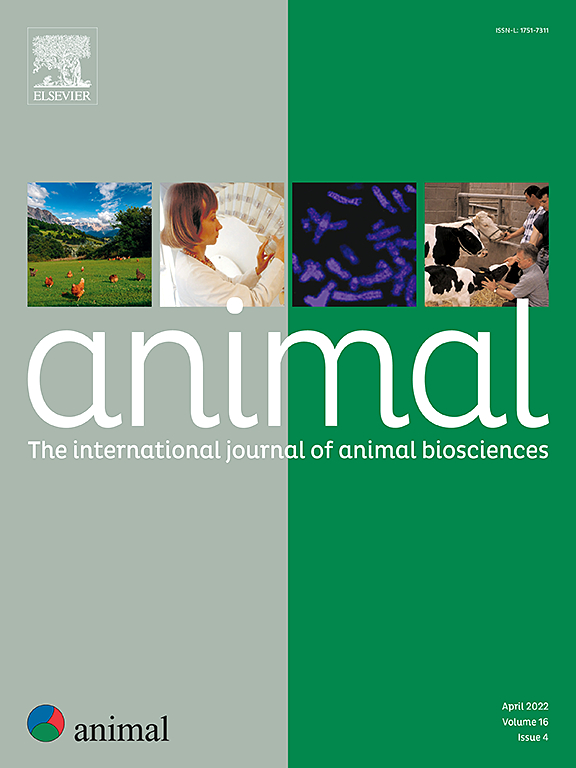Feeding on the move: assessing the effect of feeding during long-distance ferry transport on the physiology, clinical signs of disease and activity of unweaned calves
IF 4.2
2区 农林科学
Q1 AGRICULTURE, DAIRY & ANIMAL SCIENCE
引用次数: 0
Abstract
Long-distance transport of unweaned calves and associated fasting can negatively impact their physiology, and practical strategies to mitigate extended fasting times have not been studied previously. This study aimed to assess changes in the physiology, clinical signs of disease, and activity of unweaned calves as a result of providing access to feed (milk replacer) on board a trailer during a road/ferry/road journey from Ireland to The Netherlands. Calves were transported from an assembly centre (Ireland), via lairage (France), to a veal farm (The Netherlands). Calves were provided milk replacer on-board the trailer during the ferry section of the transport using an on-board feeding system (FEED; n = 40), or included as controls (CONT; n = 60). Calves were blood sampled and weighed, and clinical signs of disease were scored prior to departure from Ireland (Day 0), upon arrival at the lairage (Day 1), upon arrival at the veal farm (Day 2), and 1−week postarrival (Day 9). A subset of calves were equipped with activity sensors and continuous glucose monitors (CGM). Most blood variables differed between FEED and CONT calves on Day 1; glucose was higher (4.8 vs 4.0 mmol/L) and beta-hydroxybutyrate (0.20 vs 0.34 mmol/L), non-esterified fatty acids (0.52 vs 0.71 mmol/L), and lactate (0.85 vs 1.25 mmol/L) were lower for FEED compared to CONT calves; no blood variables showed significant differences at the next timepoint (all P > 0.05). Clinical signs of disease and BW did not reveal significant differences between treatment groups during transport. Step count was higher for FEED than for CONT calves at the time of feeding on the ferry (172 vs 37 steps/h), but not at any other time. CGM glucose was higher for FEED calves at 21 h (5.9 vs 4.9 mmol/L) and 22 h (6.0 vs 4.9 mmol/L), but lower for FEED calves at 27 h (7.4 vs 9.3 mmol/L), 28 h (7.9 vs 9.1 mmol/L), and 30 h (7.3 vs 8.3 mmol/L). In general, blood variables showed a shift towards normal ranges after on-board feeding; however, these effects diminished following a second prolonged fasting period after lairage in France. Differences in clinical signs of disease, weights, activity, and CGM were inconsistent across time points. On-board provision of milk replacer is currently challenging but has the potential to improve the physiological status of calves. Systems need to be developed further, and more research is needed to perfect the on-board feeding of calves during transport.
移动喂养:评估长途轮渡运输期间喂养对未断奶犊牛生理、疾病临床症状和活动的影响
未断奶犊牛的长途运输和相关的禁食会对其生理产生负面影响,而减轻延长禁食时间的实际策略先前尚未研究过。本研究旨在评估在从爱尔兰到荷兰的公路/渡轮/公路旅行中,在拖车上提供饲料(代乳品)的结果,对未断奶犊牛的生理、疾病临床症状和活动的变化。小牛被从装配中心(爱尔兰),经由农场(法国)运送到小牛肉农场(荷兰)。在运输的轮渡部分,小牛在拖车上使用车载喂养系统(FEED;n = 40),或作为对照(CONT;n = 60)。犊牛在离开爱尔兰前(第0天)、到达牧场时(第1天)、到达小牛肉农场时(第2天)和比赛后1周(第9天)采集血液并称重,并对疾病的临床症状进行评分。一部分小牛配备了活动传感器和连续血糖监测仪(CGM)。在第1天,饲料喂养和对照组犊牛的大多数血液变量存在差异;与对照组相比,饲料犊牛的葡萄糖含量更高(4.8 vs 4.0 mmol/L), β -羟基丁酸(0.20 vs 0.34 mmol/L),非酯化脂肪酸(0.52 vs 0.71 mmol/L)和乳酸(0.85 vs 1.25 mmol/L);在接下来的时间点,没有血液变量显示出显著差异(所有P >;0.05)。在运输过程中,疾病的临床症状和体重在治疗组之间没有显着差异。在轮渡上喂食时,饲料犊牛的步数高于对照犊牛(172步/小时vs 37步/小时),但在其他任何时间都没有。在21 h (5.9 vs 4.9 mmol/L)和22 h (6.0 vs 4.9 mmol/L)时,FEED犊牛的CGM葡萄糖较高,但在27 h (7.4 vs 9.3 mmol/L)、28 h (7.9 vs 9.1 mmol/L)和30 h (7.3 vs 8.3 mmol/L)时,FEED犊牛的CGM葡萄糖较低。总的来说,在船上喂食后,血液变量向正常范围转移;然而,在法国分娩后的第二次长时间禁食后,这些效果减弱了。临床症状、体重、活动和CGM的差异在不同时间点不一致。在船上提供代乳品目前具有挑战性,但有可能改善犊牛的生理状况。系统需要进一步发展,需要更多的研究来完善运输过程中小牛的车载喂养。
本文章由计算机程序翻译,如有差异,请以英文原文为准。
求助全文
约1分钟内获得全文
求助全文
来源期刊

Animal
农林科学-奶制品与动物科学
CiteScore
7.50
自引率
2.80%
发文量
246
审稿时长
3 months
期刊介绍:
Editorial board
animal attracts the best research in animal biology and animal systems from across the spectrum of the agricultural, biomedical, and environmental sciences. It is the central element in an exciting collaboration between the British Society of Animal Science (BSAS), Institut National de la Recherche Agronomique (INRA) and the European Federation of Animal Science (EAAP) and represents a merging of three scientific journals: Animal Science; Animal Research; Reproduction, Nutrition, Development. animal publishes original cutting-edge research, ''hot'' topics and horizon-scanning reviews on animal-related aspects of the life sciences at the molecular, cellular, organ, whole animal and production system levels. The main subject areas include: breeding and genetics; nutrition; physiology and functional biology of systems; behaviour, health and welfare; farming systems, environmental impact and climate change; product quality, human health and well-being. Animal models and papers dealing with the integration of research between these topics and their impact on the environment and people are particularly welcome.
 求助内容:
求助内容: 应助结果提醒方式:
应助结果提醒方式:


